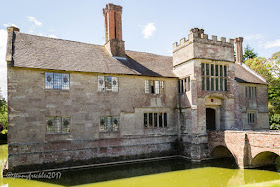
The Royal Shakespeare Theatre in Stratford upon Avon was first opened (next to the site of an earlier Victorian theatre that burnt down) in 1932, designed by Elisabeth Scott (and thus the first important building in Britain to have been designed by a woman). It retains many of its original art deco features, although it was extensively renovated, extended and transformed in 2010, to improve both the visitor experience and the conditions for actors and crew.
It is not, in my opinion, a particularly beautiful building. From some angles it looks like a utilitarian community hall and is rather rambling inside. It's a Grade II* listed building. It must be difficult to work with such an iconic 'national treasure'. The theatre is privately owned by the Royal Shakespeare Company, dedicated to performing the works of William Shakespeare and his contemporaries, as well as producing new work by living authors and touring extensively, both here and abroad.
The public areas have many photos of current and past productions and some costumes and props on display. I spotted a huge poster of David Tennant as King Lear. I'd love to have seen that!


















































